As the home to an extensive array of cattle breeds for beef and dairy production, the United States is a global leader in the cattle industry. From the renowned Angus breed to the productive Holstein and even to specialized crossbreeds, the diversity among these breeds is vast and essential for various agricultural practices.
This comprehensive guide delves into the different types of cattle in the US, discussing their characteristics, significance, and role in sustainable agriculture.
Jump Links
- Introduction to Cattle Breeds in the US
- Types of Cattle in the US
- Popular Crossbreeds and Composite Breeds
- Characteristics of Different Cattle Breeds
- The Importance of Cattle Breeds for Sustainable Agriculture
- Conclusion
- Different Types of Cattle FAQs
Introduction to Cattle Breeds in the US
Overview of the US Cattle Industry
The United States boasts a dynamic and diverse cattle industry that is critical to the country’s agricultural economy. With over 90 million head of cattle, the US is one of the largest producers of beef and dairy products globally. The industry is broadly divided into beef production and dairy farming.
Beef production involves raising cattle for meat. The cattle industry is widespread across the United States, with significant concentrations in Texas, Nebraska, and Kansas. The primary dairy-producing states are California, Wisconsin, and New York.
Herd management technology is transforming cattle operations. HerdView® App® is a cloud-based application that offers real-time inventory, animal management, task scheduling, and intelligent monitoring. This data-driven approach helps ranchers and feedlots to enhance productivity.
Significance of Different Cattle Breeds in the US
Understanding and selecting the appropriate cattle breeds is vital for the success of any cattle operation. Various breeds offer distinct advantages and are suitable for specific purposes. Here are some reasons why different cattle breeds matter:
- Production Efficiency: Due to their genetic makeup, certain breeds are highly efficient in meat or milk production.
- Adaptability: Some breeds are better adapted to specific environmental conditions, making them more suitable for certain regions.
- Disease Resistance: Genetic traits in certain breeds make them more resilient to diseases.
- Consumer Preferences: Different breeds produce different meat and milk qualities, affecting consumer choices.
Types of Cattle in the US
Beef Cattle Breeds
When it comes to raising beef cattle, the choice of breed is paramount in determining the quality of meat and the operation’s overall profitability.
Each breed has unique characteristics, including growth rates, meat quality, feed efficiency, and adaptability to different environments. In the United States, ranchers often select breeds based on market demands, pasture availability, and the region’s climatic conditions. This section will delve into some of the most popular beef cattle breeds in the US, exploring the traits and qualities that make them stand out.
Angus

- Originated in Scotland.
- Black or red coat.
- Renowned for the high quality of meat, marbling characteristics, and tender beef.
- Suitable for both purebred and crossbreeding programs.
Hereford

- Originated in England.
- Red body with a white face and can be either horned or polled.
- Well-adapted to various climatic conditions.
- They are known for good foraging abilities, docile temperament, and high-quality beef.
Texas Longhorn
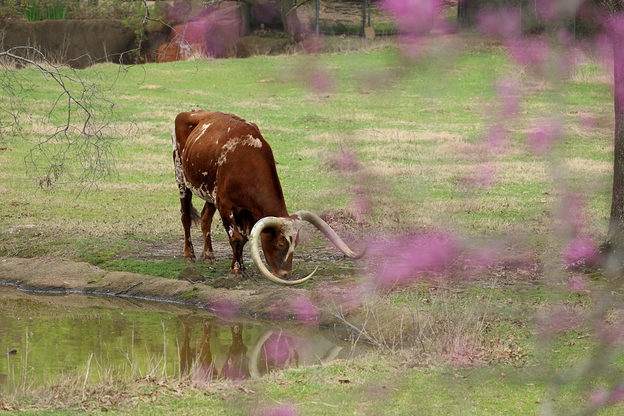
- They were developed in the US, descending from Spanish cattle.
- They are recognizable by their long, curved horns and varied coat colors.
- They are known for their adaptability, hardiness, and lean meat.
Simmental
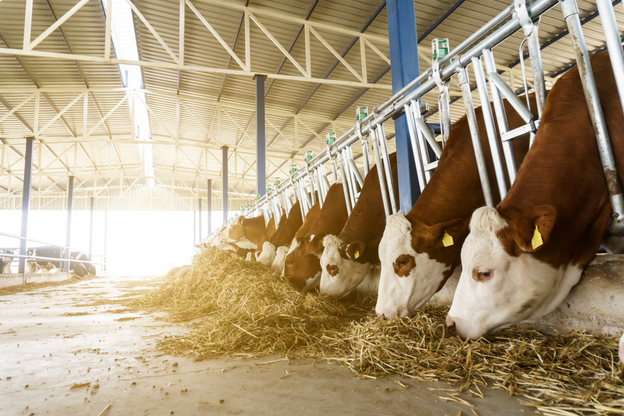
- Simmental is among the oldest and most diverse cattle breeds, originating from Switzerland.
- Solid colored or red and white.
- They are known for rapid growth, muscle development, and good milk production in females.
Charolais
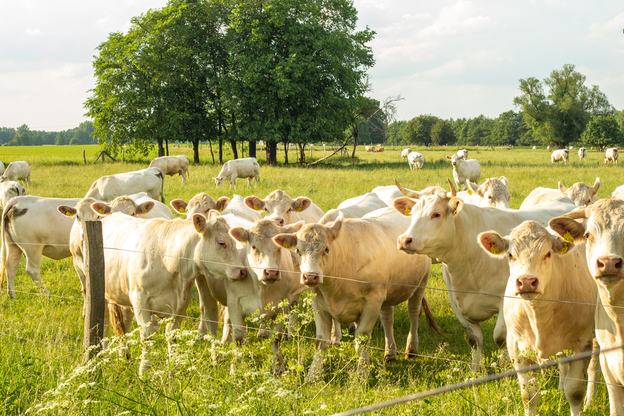
- Originated in France.
- White to cream-colored coat.
- Highly muscled, known for their exceptional growth rates and high-quality meat cuts.
Limousin
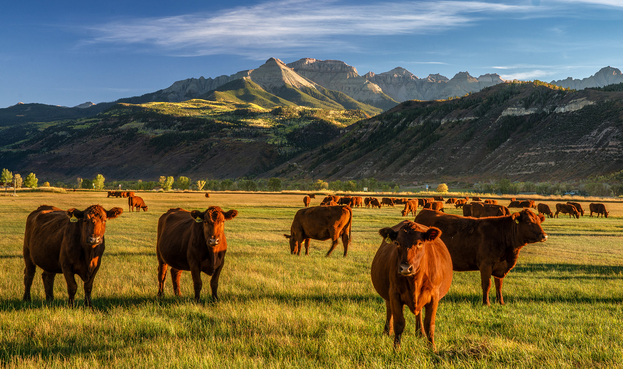
- Limousin are another breed that originated in France.
- Red or golden coat.
- Lean, fine-grained meat and known for its adaptability to different feeding programs.
Red Angus
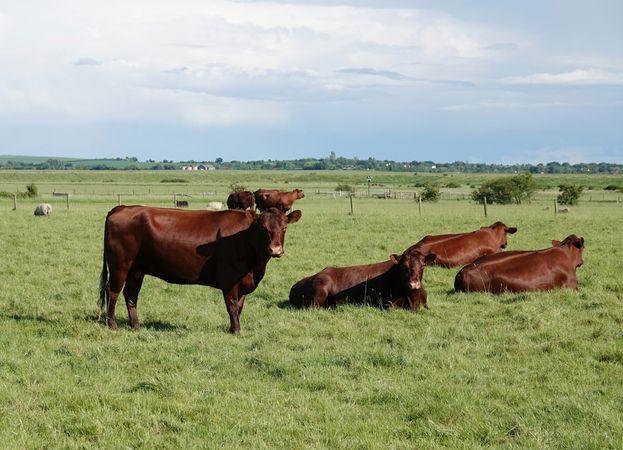
- Originated in the British Isles.
- Solid red coat.
- Similar to Angus but in red color. Known for high-quality beef and good maternal traits.
Dairy Cattle Breeds
Dairy farming is an important sector within the U.S. agriculture industry, and the choice of cattle breeds plays a critical role in milk production. Different breeds of dairy cattle vary in milk yield, composition, adaptability to various environments, and management needs.
Selecting the right breed is essential to optimize milk production and ensure the sustainability of the dairy enterprise. A range of dairy cattle breeds in the United States is utilized, each offering specific advantages. Let’s look at some of the predominant dairy cattle breeds and what they bring.
Holstein
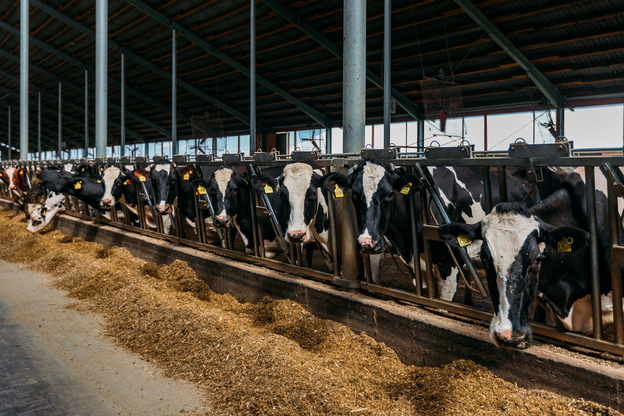
- Originated in the Netherlands.
- Black and white spotted coat.
- Known for high milk production but has a lower butterfat content.
Jersey
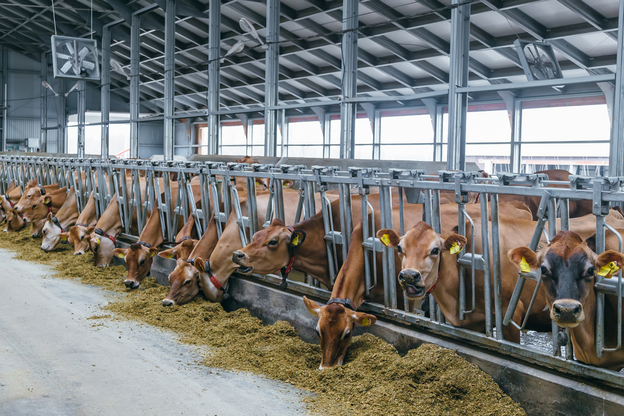
- Originated on the Island of Jersey in the English Channel.
- Light brown coat.
- Smaller in size, known for the high butterfat content in their milk, making it ideal for cheese production.
Guernsey
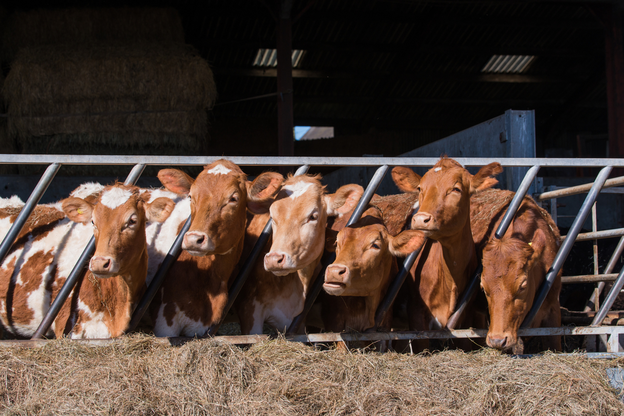
- Originated on the Island of Guernsey in the English Channel.
- Red and white coat.
- They are known for rich, flavorful milk with high levels of beta-carotene.
Ayrshire

- Originated in Scotland.
- Red and white coat.
- Noted for the efficiency of milk production and the ability to adapt to various management systems.
Brown Swiss
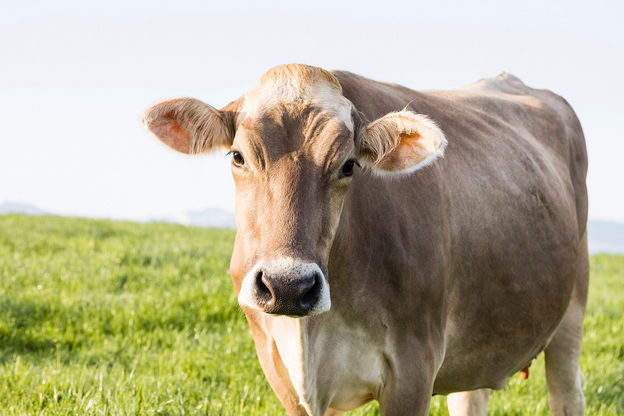
- One of the oldest dairy breeds originated in Switzerland.
- Greyish-brown to dark brown coat.
- They are known for their docile temperament and the ability to produce large quantities of milk with high butterfat content.
Milking Shorthorn

- Originated in England.
- Red, white, red and white, or roan coat.
- They are known for their versatility in meat and milk production and adaptability to various environments and management practices.
Popular Crossbreeds and Composite Breeds
Crossbreeding and developing composite breeds have become essential strategies in modern cattle farming. By combining the genetics of different breeds, ranchers and dairy farmers can optimize specific traits such as meat quality, milk yield, environmental adaptation, and disease resistance.
Crossbreeding is often used to improve hybrid vigor, which results in enhanced performance and productivity in the offspring. Composite breeds, on the other hand, are developed by systematically crossing several breeds and then breeding the crosses among themselves. This section will explore some of the popular crossbreeds and composite breeds in the United States and discuss how they contribute to the cattle industry’s diversity and productivity.
Beef x Beef Crossbreeds
Brafords

- A cross between Brahman and Hereford.
- Red coat with a white face.
- They are known for their heat tolerance, hardiness, and ability to perform well in harsh conditions.
Wagyu

- Origin and Quality: Wagyu beef originates from Japan and is renowned for its exceptional marbling, which leads to a rich buttery flavor and unparalleled tenderness.
- American Wagyu: In the United States, Wagyu cattle are often crossbred with other breeds like Angus, creating American Wagyu. This variation combines the marbling characteristics of Wagyu with the hardiness and growth rates of American breeds.
- Health Benefits: Wagyu beef contains higher percentages of monounsaturated fats and omega-3 and omega-6 fatty acids than regular beef, making it a healthier option when consumed in moderation.
- Luxury Product: Considered a luxury product, Wagyu beef is often featured in high-end restaurants and is sought after for its premium quality. It has several grades, with the highest being the most marbled and thus the most expensive.
Bran

gus
- A cross between Brahman and Angus.
- Solid black or red coat.
- Combine the traits of Angus and Brahman, known for meat quality, heat tolerance, and disease resistance.
Beefmaster

- Developed in the US by crossing Brahman, Hereford, and Shorthorn.
- Various coat colors.
- They were developed for optimal beef production traits, including weight gain, fertility, and disposition.
Dairy x Dairy Crossbreeds
Montbeliarde
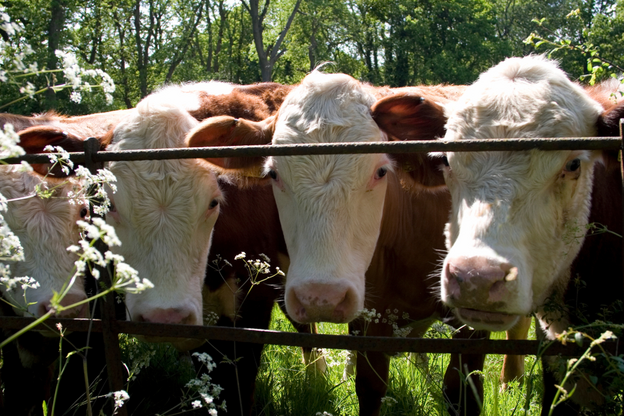
- Developed in France.
- Red and white coat.
- They are known for high milk yields with good protein and fat content.
Normande
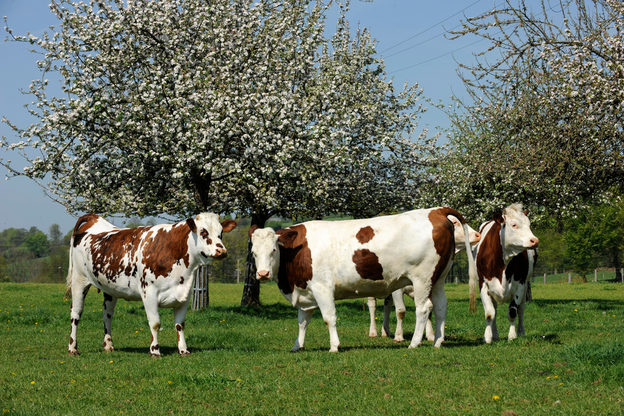
- Originated in France.
- Red pied or black pied coat.
- Known for the ability to produce high-quality milk for cheese production.
Beef x Dairy Crossbreeds
ProCross
- A cross between Holstein, Montbéliarde, and Viking Red breeds.
- Developed for high production efficiency and improved fertility.
New Zealand Friesian/Jersey Cross
- Combines the traits of Friesian and Jersey breeds.
- Efficient conversion of feed into milk solids.
Characteristics of Different Cattle Breeds
Understanding the unique characteristics of different cattle breeds can significantly improve decision-making when selecting the most appropriate breed for your ranch or dairy farm.
Breed and Production Performance
Milk Production
- Holstein: Highest milk production but lower butterfat content.
- Jersey and Guernsey: Lower milk production than Holstein but higher butterfat content.
Meat Production
- Angus and Hereford: Known for high-quality beef with excellent marbling.
- Charolais and Limousin: Exceptional growth rates and high yields of lean meat.
Growth Rates
- Charolais: Known for rapid growth.
- Angus: Moderate growth rates but early maturing.
Breed and Environmental Adaptability
Heat Tolerance
- Brahman and Brahman Crosses (Brangus, Beefmaster, Brafords): Excellent heat tolerance due to their origins in tropical climates.
Cold Tolerance
- Hereford and Angus: Adapt well to cold climates.
Disease Resistance
- Brahman Crosses: Known for resistance to certain pests and diseases.
Breed and Handling Characteristics
Temperament
- Angus and Hereford: Generally docile.
- Brahman Crosses: Maybe more temperamental due to Brahman’s influence.
Maternal Traits
- Angus and Red Angus: Known for strong maternal traits, including good mothering abilities and milk production.
Calving Ease
- Angus: Known for easy calving.
- Charolais: Larger calf size may sometimes cause difficulties in calving.
The Importance of Cattle Breeds for Sustainable Agriculture
Genetic Diversity and Conservation
Maintaining a diverse array of cattle breeds is crucial for the sustainability of the agriculture industry. Genetic diversity within cattle breeds can:
- Enhance resilience to diseases and environmental changes.
- Provide a gene pool for breeding programs aimed at improving specific traits.
Meeting Consumer Demands
Consumer preferences for meat and dairy products can vary. By raising breeds that produce the characteristics consumers are looking for, producers can cater to market demands.
- Angus and Wagyu: Highly sought after for marbled beef.
- Jersey: Milk is popular for cheese production due to its high butterfat content.
Conclusion
Current Trends in US Cattle Breeds
As we reach the end of this guide, it is essential to understand the current trends shaping the selection and use of different cattle breeds in the United States.
There is a growing preference for cattle breeds that are adaptable, efficient, and can meet specific market demands. Angus, Hereford, and Simmental breeds dominate the beef industry due to their superior meat quality and efficient feed conversion rates. Crossbreeding is gaining popularity as ranchers strive to combine the favorable traits of two or more breeds. This can lead to hybrid vigor, better growth rates, and improved resilience.
Holsteins remain the most popular breed in the dairy sector due to their high milk production. However, interest in other breeds like Jerseys is growing, particularly in artisanal cheese production, where milk composition is as important as volume.
Future Outlook
The cattle industry is likely to continuously evolve. There is a burgeoning interest in sustainability and environmental conservation. Consequently, cattle breeds well-adapted to local environments can produce more efficiently with fewer inputs and may gain prominence.
Technological advancements, such as those provided by HerdX®’s HerdView® App® and HerdView® Insights, are likely to play a role in managing and selecting cattle breeds. These technologies can support more informed and effective decision-making by offering ranchers in-depth insights into cattle performance, genetics, and health.
In conclusion, the choice of cattle breeds plays a pivotal role in the productivity and sustainability of ranching operations. Understanding the characteristics of different breeds and making choices that align with specific goals, market demands, and environmental conditions is crucial. Tools like HerdView® App® and HerdView® Insights can provide invaluable support, helping ranchers optimize their operations for long-term success.
Different Types of Cattle FAQs
Which cattle breed is the most profitable for beef production in the US?
The profitability of a cattle breed for beef production can vary depending on several factors, including feed costs, market demands, and climate. Angus is often among the most profitable breeds due to its popularity and high-quality meat.
What is the most common dairy cattle breed in the US?
The Holstein is the most common dairy cattle breed in the US, known for its high milk production.
Are there any cattle breeds that are native to the US?
The Texas Longhorn is among the cattle breeds considered native to the US.
How do environmental factors influence the selection of cattle breeds?
Environmental factors such as climate, altitude, and disease prevalence can influence the suitability of certain cattle breeds for a given region. For example, Brahman and its crosses are more suitable for humid climates due to their heat tolerance.
How can technology like HerdX®’s HerdView® Insights help manage different cattle breeds?
HerdX®’s HerdView® Insights can be instrumental in managing different cattle breeds by providing detailed analytics and insights on various aspects such as growth rates, and health statistics. This data can help farmers make informed decisions on breeding strategies, feeding programs, and health management, which are vital for optimizing the productivity and profitability of different cattle breeds. The tool’s real-time monitoring capabilities also allow for prompt intervention, further enhancing herd management.
